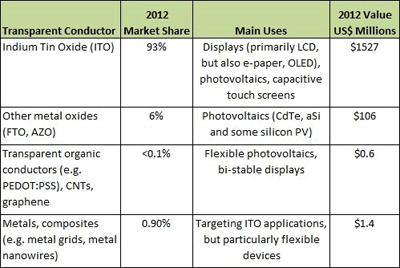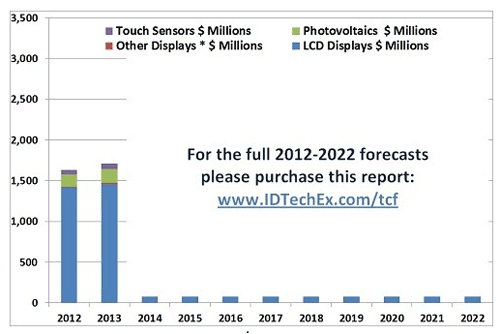ITO Alternatives to Gain Speed in the $2 Billion TCF Market
BY CATHLEEN THIELE, Technology Analyst, IDTechEx
Today, only one type of film – Indium Tin Oxide (ITO) – is used for almost all transparent conductive films with a market size of over $2 billion this year. It is entrenched in the display industry and will be hard to displace. However, there is an interest to move away from this and there are now many alternative solutions emerging. These include finely printed conductive meshes, layers of silver or copper that are highly transparent, organic transparent conductors and variations such as carbon nanotubes and graphene. These solutions are discussed in the recently updated IDTechEx report Transparent Conductive Films 2012-2022.
The commonly used options (excluding uses of transparent conductors that are not in displays, photovoltaics or touchscreens) with their market share today is shown in this table:

Source: IDTechEx http://www.IDTechEx.com/TCF
Transparent conductors based on nanosilver and PEDOT:PSS are getting a lot of interest, in addition to carbon nanotubes and graphene. There are also hybrid approaches – using nanosilver to print fine lines, filled with a transparent conductor such as PEDOT:PSS.
Most of the focus is on use as a transparent conductor for display, solar and touchscreen applications – representing the biggest need and opportunity.
This figure shows our forecast and outlines the market segments covered in our analysis.

Transparent conductive film market 2012-2022 US$ millions:


Flexible Electronics
In comparison to other types of transparent conductors ITO has a very competitive conductivity-transparency-ratio. However, an issue not only for ITO, but also many other types of TCF, is that they are not particularly flexible. Sputtered ITO and other TCO layers on plastic films are known to be brittle, and they crack upon a few percent strain.
As more and more flexible devices are required, the market for transparent conductive films increases. The trade-off between conductivity, transmittance, and flexibility is best met with materials other than the traditional conductive oxides, which are expected to get more expensive as in the case of ITO, and many companies and research institutes work on alternate technologies.
Flexible E-Reader and Touchscreens
The recent developments in the e-Reader market are a good example of the interest to move to flexible displays: While the first devices where rigid and based on glass, new versions are intended to eventually be somewhat flexible, though a rollable device is still a dream.
In addition, some are targeting to replace ITO in applications where high conductivity is not needed – e-readers are an excellent example of that.
Eastman Kodak sees the opportunity for their PEDOT formulation in applications where customers seek cheaper alternatives than ITO and where a more resistive film is acceptable. Together with Heraeus they presented a milestone at the Printed Electronics USA 2011 Show – a polymer-based 14” touch screen panel featuring completely invisible conductive patterns. Fabricated by GSI Technologies the panel features Kodak HCF-225 Film/ESTAR™ Base and transparent Clevios™ PEDOT:PSS coating with a surface resistivity of 225 ohms/sq.
Flexible Photovoltaics
The same is true for photovoltaics; thin-film solar cells based on compound semiconductors or amorphous silicon are manufactured in industrial scales on glass, but flexible versions on plastic substrates are available and will open new applications and markets.
Moreover, the PV market seeks very large areas of transparent conductive material and therefore must reduce cost as much as possible to maintain competitive cost/watt pricing. Therefore some in the PV market have moved away from ITO already: a-Si manufacturers for example use ITO, FTO and AZO, First Solar (CdTe solar cells) is using FTO and most CIGS PV manufacturers use AZO.
Report Overview
This report focuses on the requirements and achievements to date on the topic of transparent conductors, where high transparency and high conductivity are required, particularly flexible versions. Worldwide research and design efforts are presented, both from research institutes and companies that are developing the necessary materials and processes – in total 53 organizations are profiled. Several technical solutions available are compared, and forecasts are given for the next 10 years, based on assessing the need from different applications.
To learn more about the topic please read Transparent Conductive Films 2012-2022, www.idtechex.com/research/reports/transparent-conductive-films-for-flexible-electronics-2012-2022-000307.asp. ■
Advertisement
Learn more about IDTechEx





